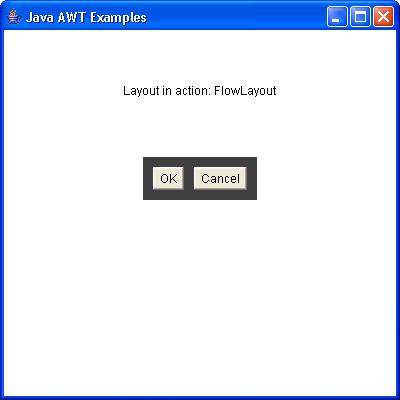
- AWT - Home
- AWT - Overview
- AWT - Environment
- AWT - Controls
- AWT - Event Handling
- AWT - Event Classes
- AWT - Event Listeners
- AWT - Event Adapters
- AWT - Layouts
- AWT - Containers
- AWT - Menu
- AWT - Graphics
AWT - Useful Resources
AWT FlowLayout Class
Introduction
The class FlowLayout components in a left-to-right flow.
Class declaration
Following is the declaration for java.awt.FlowLayout class:
public class FlowLayout
extends Object
implements LayoutManager, Serializable
Field
Following are the fields for java.awt.BorderLayout class:
static int CENTER -- This value indicates that each row of components should be centered.
static int LEADING -- This value indicates that each row of components should be justified to the leading edge of the container's orientation, for example, to the left in left-to-right orientations.
static int LEFT -- This value indicates that each row of components should be left-justified.
static int RIGHT -- This value indicates that each row of components should be right-justified.
static int TRAILING -- This value indicates that each row of components should be justified to the trailing edge of the container's orientation, for example, to the right in left-to-right orientations.
Class constructors
| S.N. | Constructor & Description |
|---|---|
| 1 |
FlowLayout() Constructs a new FlowLayout with a centered alignment and a default 5-unit horizontal and vertical gap. |
| 2 |
FlowLayout(int align) Constructs a new FlowLayout with the specified alignment and a default 5-unit horizontal and vertical gap. |
| 3 |
FlowLayout(int align, int hgap, int vgap) Creates a new flow layout manager with the indicated alignment and the indicated horizontal and vertical gaps. |
Class methods
| S.N. | Method & Description |
|---|---|
| 1 |
void addLayoutComponent(String name, Component comp) Adds the specified component to the layout. |
| 2 |
int getAlignment() Gets the alignment for this layout. |
| 3 |
int getHgap() Gets the horizontal gap between components. |
| 4 |
int getVgap() Gets the vertical gap between components. |
| 5 |
void layoutContainer(Container target) Lays out the container. |
| 6 |
Dimension minimumLayoutSize(Container target) Returns the minimum dimensions needed to layout the visible components contained in the specified target container. |
| 7 |
Dimension preferredLayoutSize(Container target) Returns the preferred dimensions for this layout given the visible components in the specified target container. |
| 8 |
void removeLayoutComponent(Component comp) Removes the specified component from the layout. |
| 9 |
void setAlignment(int align) Sets the alignment for this layout. |
| 10 |
void setHgap(int hgap) Sets the horizontal gap between components. |
| 11 |
void setVgap(int vgap) Sets the vertical gap between components. |
| 12 |
String toString() Returns a string representation of this FlowLayout object and its values. |
Methods inherited
This class inherits methods from the following classes:
java.lang.Object
FlowLayout Example
Create the following java program using any editor of your choice in say D:/ > AWT > com > tutorialspoint > gui >
AwtLayoutDemo.java
package com.tutorialspoint.gui;
import java.awt.*;
import java.awt.event.*;
public class AwtLayoutDemo {
private Frame mainFrame;
private Label headerLabel;
private Label statusLabel;
private Panel controlPanel;
private Label msglabel;
public AwtLayoutDemo(){
prepareGUI();
}
public static void main(String[] args){
AwtLayoutDemo awtLayoutDemo = new AwtLayoutDemo();
awtLayoutDemo.showFlowLayoutDemo();
}
private void prepareGUI(){
mainFrame = new Frame("Java AWT Examples");
mainFrame.setSize(400,400);
mainFrame.setLayout(new GridLayout(3, 1));
mainFrame.addWindowListener(new WindowAdapter() {
public void windowClosing(WindowEvent windowEvent){
System.exit(0);
}
});
headerLabel = new Label();
headerLabel.setAlignment(Label.CENTER);
statusLabel = new Label();
statusLabel.setAlignment(Label.CENTER);
statusLabel.setSize(350,100);
msglabel = new Label();
msglabel.setAlignment(Label.CENTER);
msglabel.setText("Welcome to TutorialsPoint AWT Tutorial.");
controlPanel = new Panel();
controlPanel.setLayout(new FlowLayout());
mainFrame.add(headerLabel);
mainFrame.add(controlPanel);
mainFrame.add(statusLabel);
mainFrame.setVisible(true);
}
private void showFlowLayoutDemo(){
headerLabel.setText("Layout in action: FlowLayout");
Panel panel = new Panel();
panel.setBackground(Color.darkGray);
panel.setSize(200,200);
FlowLayout layout = new FlowLayout();
layout.setHgap(10);
layout.setVgap(10);
panel.setLayout(layout);
panel.add(new Button("OK"));
panel.add(new Button("Cancel"));
controlPanel.add(panel);
mainFrame.setVisible(true);
}
}
Compile the program using command prompt. Go to D:/ > AWT and type the following command.
D:\AWT>javac com\tutorialspoint\gui\AwtlayoutDemo.java
If no error comes that means compilation is successful. Run the program using following command.
D:\AWT>java com.tutorialspoint.gui.AwtlayoutDemo
Verify the following output
